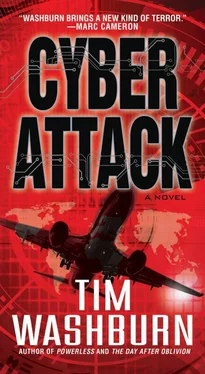Tim Washburn - Cyber Attack
Здесь есть возможность читать онлайн «Tim Washburn - Cyber Attack» весь текст электронной книги совершенно бесплатно (целиком полную версию без сокращений). В некоторых случаях можно слушать аудио, скачать через торрент в формате fb2 и присутствует краткое содержание. Город: New York, Год выпуска: 2018, ISBN: 2018, Издательство: Pinnacle Books, Жанр: Триллер, на английском языке. Описание произведения, (предисловие) а так же отзывы посетителей доступны на портале библиотеки ЛибКат.
- Название:Cyber Attack
- Автор:
- Издательство:Pinnacle Books
- Жанр:
- Год:2018
- Город:New York
- ISBN:978-0-7860-4253-1
- Рейтинг книги:5 / 5. Голосов: 1
-
Избранное:Добавить в избранное
- Отзывы:
-
Ваша оценка:
- 100
- 1
- 2
- 3
- 4
- 5
Cyber Attack: краткое содержание, описание и аннотация
Предлагаем к чтению аннотацию, описание, краткое содержание или предисловие (зависит от того, что написал сам автор книги «Cyber Attack»). Если вы не нашли необходимую информацию о книге — напишите в комментариях, мы постараемся отыскать её.
Cyber Attack — читать онлайн бесплатно полную книгу (весь текст) целиком
Ниже представлен текст книги, разбитый по страницам. Система сохранения места последней прочитанной страницы, позволяет с удобством читать онлайн бесплатно книгу «Cyber Attack», без необходимости каждый раз заново искать на чём Вы остановились. Поставьте закладку, и сможете в любой момент перейти на страницу, на которой закончили чтение.
Интервал:
Закладка:
Tim Washburn
CYBER ATTACK
This book is dedicated to:
Loren and Frances Washburn
and
Jack and Sue Cress
CHAPTER 1
Washington Dulles International Airport
The skyline around Dulles International Airport changed significantly in 2007, thanks to the construction of a new air traffic control tower that soars 325 feet above the surrounding landscape. With a panoramic view of the entire airport, the air traffic controllers are now able to visually see the runways and taxiways that funnel nearly twenty-two million passengers in and out of the airport every year. With that many people coming and going, Dulles is a busy place, especially for the air traffic controllers responsible for safely organizing the chaos that comes with two thousand daily flights. And if that wasn’t enough to cause heartburn, the air traffic controllers must face the reality that the tiniest mistake could lead to a major catastrophe.
But for Adam Baldwin it’s just another day at work. He’s accustomed to the pressure working as a flight controller inside the tower at Washington Dulles. Nine years on the job, Baldwin has seen a little bit of everything, from aborted takeoffs to emergency landings. The one thing Baldwin has never witnessed is a passenger jet crash and he has no desire to see one, especially on his watch.
Today Baldwin is working departures on runway 1C. He glances out the window to see how many aircraft are lined up for departure. The airport had a small hiccup earlier that put them behind and now he’ll need to play catch-up to get back on schedule. Baldwin does like the unfettered view from the top of the tower, but all that glass also allows the sun in, creating a hotbox the air-conditioning unit is struggling to cool on this hot August day. Glancing up at one of the large video screens hanging from the ceiling, Baldwin checks the scheduled departure times and compares it to the current time. They’re fifteen minutes behind, something he’ll hear about at the end of his shift, but he can’t make the planes fly any faster. He triggers his radio and says, “AirExpress 1423, you are cleared for takeoff. Please contact Potomac departure at 125.05.”
Baldwin leans back in his chair and pulls the headset from his head to dry moisture collected in his ear canal. Inside the tower, Baldwin sweats on even the coldest days of the year. The sweating is in direct relation to the extra fifty pounds he’s packed on since college and the intensive nature of his job. After swabbing his inner ear with a pinky finger, he repositions his headset and stacks the paper strip for the next departure at the bottom of his flight board. They’re still using the paper strips because the last significant computer upgrade for the Federal Aviation Administration’s flight systems occurred in 1999. And even then, the software was already outdated. In 2003, the FAA began the process of upgrading the nation’s air traffic control system with their NextGen system, but like most government programs, it’s years behind schedule and billions of dollars over budget. Installation of the new system did start last year at Dulles, but it’s not yet operational, leaving Baldwin and his team with their pencils and paper strips.
Baldwin scans the radar as the last plane to depart makes a right-hand turn. He triggers his radio. “Transjet 1536, Dulles Tower. You are next for departure.” He watches as the heavy jet taxis into the center of the runway and holds, waiting for Baldwin to give the all clear. He glances at his departure board and radios another jet to tell them they’re clear to taxi. As the planes continue to back up on the runway, the sweat begins to roll down Baldwin’s back in waves. He checks the radar to make sure the last departure has cleared the airspace and triggers his radio again, saying, “Transjet 1536, Dulles Tower. You are clear for departure.” He follows the plane’s progress through the window as the pilot pushes the throttles to the stops and the jet picks up speed. Baldwin slots his next departure and then, without warning, the power in the tower flashes off. Shift supervisor Elise Carleton steps into the center of the room and takes charge. “Where the hell is the generator?” she shouts. “Hold all departures and have all aircraft maintain current positions.”
“How the hell are we supposed to do that?” Baldwin shouts, removing his headset. “The radios are down.”
Carleton mutters something about how much she loves her job and pulls the microphone away from her lips, snatching up the phone. She punches in an extension and waits for the call to be answered. After several seconds of silence she realizes the phones also aren’t working. “Somebody”—she looks around and points at another supervisor—“run downstairs to check on the generator.”
The supervisor hurries to the door and begins the long climb down.
There’s a roar as Transjet 1536 passes by the tower, zooming toward takeoff speed.
“Who’s taking off?” Carleton shouts.
“Transjet 1536,” Baldwin says. “They were cleared.”
“How the hell are you going to track them, Adam?” Carleton says.
Baldwin stares at his dead headset. “I don’t know. I can’t radio them to abort.”
“Jesus Christ, what a mess,” Carleton says.
Seconds later, the generator kicks on but they have to wait for the antiquated systems to reboot. Baldwin snaps on his headset and waits for the radio to power up, his eyes glued to the jet now lumbering down the runway. He hears a beep signaling the radio is up and running and he relaxes a little when the plane lifts off. Baldwin triggers his microphone and says, “Transjet 1536, please contact Potomac departure.”
“1536. Roger, Dulles Tower—what the hell? Dulles, we seem to be having engine—damn, dial back the engi—”
Baldwin triggers the radio. “Repeat, Transjet 1536.” Baldwin waits for a reply and when it doesn’t come, says, “Transjet 1536. What is the problem?” He pumps his right leg, mentally begging the pilot to respond.
Baldwin nearly jumps out of his chair when a massive explosion rattles the building to its core. Every eye in the room is drawn to the end of runway 1C, where a fireball is blooming high into the sky. Baldwin’s hands begin to tremble as he triggers his microphone again, saying, “Transjet 1536? Dulles Tower to Transjet 1536, please respond.”
He pauses to listen for a response, knowing there won’t be one.
CHAPTER 2
Calvert Cliffs Nuclear Power Plant
Lusby, Maryland
Located approximately fifty miles from Washington, D.C., Maryland’s only nuclear power plant is perched along the western shore of Chesapeake Bay. Two massive concrete cylinders front a long, three-story building that houses the necessary equipment used to generate electricity. Situated inside this building is the nerve center of the plant—the control room. The walls of the room are lined with muted yellow metal cabinets, reminiscent of the harvest gold appliances that were all the rage back in the ’60s and ’70s when the plant was constructed. Although ugly, the cabinets do serve a purpose and they’re outfitted with more switches and gauges than you’d find in an Apollo spacecraft. Phones, buttons, red lights, green lights—you could spend two days looking and still not see it all. In the center of the room is a U-shaped desk equipped with more phones and an array of computer monitors. Manning the desk is David Roark, the leader of the day shift. Presently, Roark is closely monitoring the incoming voltage levels from the power grid on his computer screen. If the voltages drop to a certain level the two nuclear power generating plants could shut down, one of a dozen or so safety measures designed to protect the surrounding civilian population.
Читать дальшеИнтервал:
Закладка:
Похожие книги на «Cyber Attack»
Представляем Вашему вниманию похожие книги на «Cyber Attack» списком для выбора. Мы отобрали схожую по названию и смыслу литературу в надежде предоставить читателям больше вариантов отыскать новые, интересные, ещё непрочитанные произведения.
Обсуждение, отзывы о книге «Cyber Attack» и просто собственные мнения читателей. Оставьте ваши комментарии, напишите, что Вы думаете о произведении, его смысле или главных героях. Укажите что конкретно понравилось, а что нет, и почему Вы так считаете.












